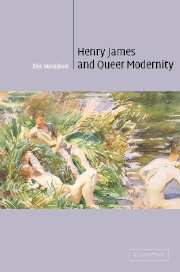Book contents
- Frontmatter
- Contents
- Acknowledgments
- List of abbreviations
- Introduction
- 1 Indiscreet anatomies and protogay aesthetes in Roderick Hudson and The Europeans
- 2 The elusive queerness of “queer comrades”: The Tragic Muse and “The Author of ‘Beltraffio’”
- 3 The Turn of the Screw, or: The Dispossessed Hearts of Little Gentlemen
- 4 Masculinity “changed and queer” in The Ambassadors
- 5 Gratifying “the eternal boy in us all”: Willa Cather, Henry James, and Oscar Wilde
- 6 “The other half is the man”: the queer modern triangle of Gertrude Stein, Ernest Hemingway, and Henry James
- Coda: “Nobody is alike Henry James.” Stein, James, and queer futurity
- Notes
- Bibliography
- Index
1 - Indiscreet anatomies and protogay aesthetes in Roderick Hudson and The Europeans
Published online by Cambridge University Press: 22 September 2009
- Frontmatter
- Contents
- Acknowledgments
- List of abbreviations
- Introduction
- 1 Indiscreet anatomies and protogay aesthetes in Roderick Hudson and The Europeans
- 2 The elusive queerness of “queer comrades”: The Tragic Muse and “The Author of ‘Beltraffio’”
- 3 The Turn of the Screw, or: The Dispossessed Hearts of Little Gentlemen
- 4 Masculinity “changed and queer” in The Ambassadors
- 5 Gratifying “the eternal boy in us all”: Willa Cather, Henry James, and Oscar Wilde
- 6 “The other half is the man”: the queer modern triangle of Gertrude Stein, Ernest Hemingway, and Henry James
- Coda: “Nobody is alike Henry James.” Stein, James, and queer futurity
- Notes
- Bibliography
- Index
Summary
Those [readers] who look for “and they lived together happily ever after” at the end of the last chapter of any of [Henry James's] novelettes will be disappointed.
(Review of Roderick Hudson, New York Herald, 1875)It is now common to advance Henry James's first acknowledged novel, Roderick Hudson (1875), as also his first significant foray into the representation of different modes of masculinity and, indeed, of male homosexuality. Robert Drake has recently canonized this narrative of “sublimated desire” in The Gay Canon (1998), predicting that “the gay reader” (comfortably unproblematized) will discover in Roderick Hudson an unfulfilled “love story” between two young American men: the titular hero, an ill-fated would-be genius as a sculptor, and his wealthy patron, Rowland Mallet. Offering a more theoretical account, Hugh Stevens stakes his claim that James was “already a gay novelist” in his early thirties (a literary not a biographical claim) on the ways in which Roderick Hudson begins “explor[ing] the workings of same-sex desire, and the difficulties of admitting such desires, within a cultural formation marked by homosexual prohibition,” albeit before the articulation of “the homosexual” as a pathologized, criminalized type in late Victorian science and jurisprudence.
- Type
- Chapter
- Information
- Henry James and Queer Modernity , pp. 27 - 53Publisher: Cambridge University PressPrint publication year: 2003



